NISSAN QASHQAI 2023 Owners Manual
Manufacturer: NISSAN, Model Year: 2023, Model line: QASHQAI, Model: NISSAN QASHQAI 2023Pages: 508, PDF Size: 2.47 MB
Page 491 of 508
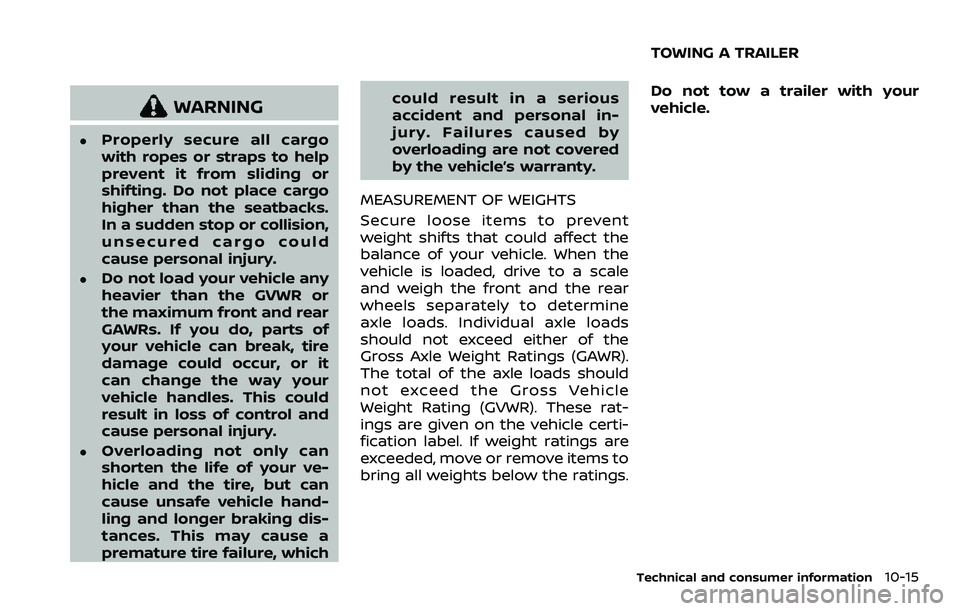
WARNING
.Properly secure all cargo
with ropes or straps to help
prevent it from sliding or
shifting. Do not place cargo
higher than the seatbacks.
In a sudden stop or collision,
unsecured cargo could
cause personal injury.
.Do not load your vehicle any
heavier than the GVWR or
the maximum front and rear
GAWRs. If you do, parts of
your vehicle can break, tire
damage could occur, or it
can change the way your
vehicle handles. This could
result in loss of control and
cause personal injury.
.Overloading not only can
shorten the life of your ve-
hicle and the tire, but can
cause unsafe vehicle hand-
ling and longer braking dis-
tances. This may cause a
premature tire failure, whichcould result in a serious
accident and personal in-
jury. Failures caused by
overloading are not covered
by the vehicle’s warranty.
MEASUREMENT OF WEIGHTS
Secure loose items to prevent
weight shifts that could affect the
balance of your vehicle. When the
vehicle is loaded, drive to a scale
and weigh the front and the rear
wheels separately to determine
axle loads. Individual axle loads
should not exceed either of the
Gross Axle Weight Ratings (GAWR).
The total of the axle loads should
not exceed the Gross Vehicle
Weight Rating (GVWR). These rat-
ings are given on the vehicle certi-
fication label. If weight ratings are
exceeded, move or remove items to
bring all weights below the ratings. Do not tow a trailer with your
vehicle.
Technical and consumer information10-15
TOWING A TRAILER
Page 492 of 508
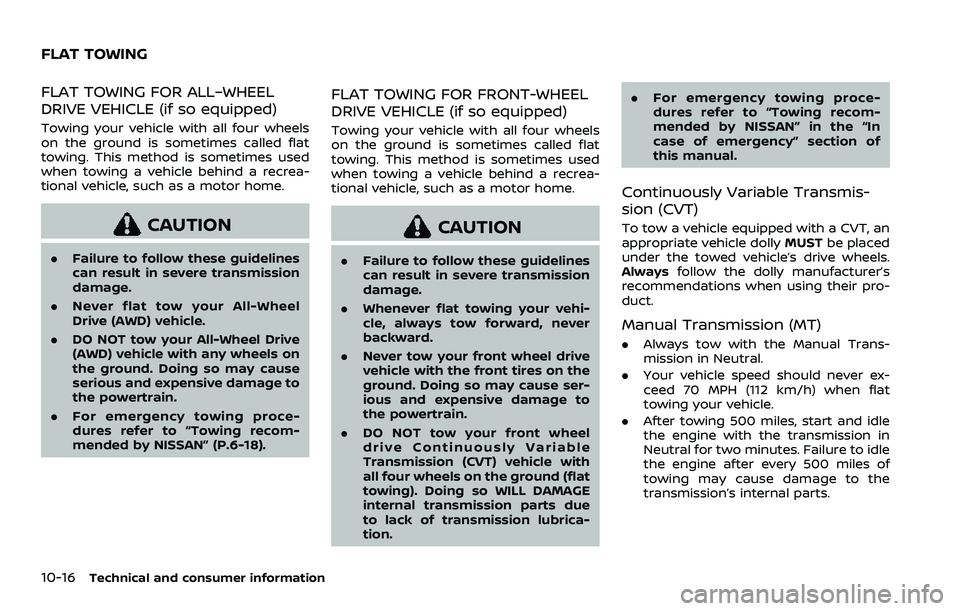
10-16Technical and consumer information
FLAT TOWING FOR ALL–WHEEL
DRIVE VEHICLE (if so equipped)
Towing your vehicle with all four wheels
on the ground is sometimes called flat
towing. This method is sometimes used
when towing a vehicle behind a recrea-
tional vehicle, such as a motor home.
CAUTION
.Failure to follow these guidelines
can result in severe transmission
damage.
. Never flat tow your All-Wheel
Drive (AWD) vehicle.
. DO NOT tow your All-Wheel Drive
(AWD) vehicle with any wheels on
the ground. Doing so may cause
serious and expensive damage to
the powertrain.
. For emergency towing proce-
dures refer to “Towing recom-
mended by NISSAN” (P.6-18).
FLAT TOWING FOR FRONT-WHEEL
DRIVE VEHICLE (if so equipped)
Towing your vehicle with all four wheels
on the ground is sometimes called flat
towing. This method is sometimes used
when towing a vehicle behind a recrea-
tional vehicle, such as a motor home.
CAUTION
.Failure to follow these guidelines
can result in severe transmission
damage.
. Whenever flat towing your vehi-
cle, always tow forward, never
backward.
. Never tow your front wheel drive
vehicle with the front tires on the
ground. Doing so may cause ser-
ious and expensive damage to
the powertrain.
. DO NOT tow your front wheel
drive Continuously Variable
Transmission (CVT) vehicle with
all four wheels on the ground (flat
towing). Doing so WILL DAMAGE
internal transmission parts due
to lack of transmission lubrica-
tion. .
For emergency towing proce-
dures refer to “Towing recom-
mended by NISSAN” in the “In
case of emergency” section of
this manual.
Continuously Variable Transmis-
sion (CVT)
To tow a vehicle equipped with a CVT, an
appropriate vehicle dolly MUSTbe placed
under the towed vehicle’s drive wheels.
Always follow the dolly manufacturer’s
recommendations when using their pro-
duct.
Manual Transmission (MT)
. Always tow with the Manual Trans-
mission in Neutral.
. Your vehicle speed should never ex-
ceed 70 MPH (112 km/h) when flat
towing your vehicle.
. After towing 500 miles, start and idle
the engine with the transmission in
Neutral for two minutes. Failure to idle
the engine after every 500 miles of
towing may cause damage to the
transmission’s internal parts.
FLAT TOWING
Page 493 of 508
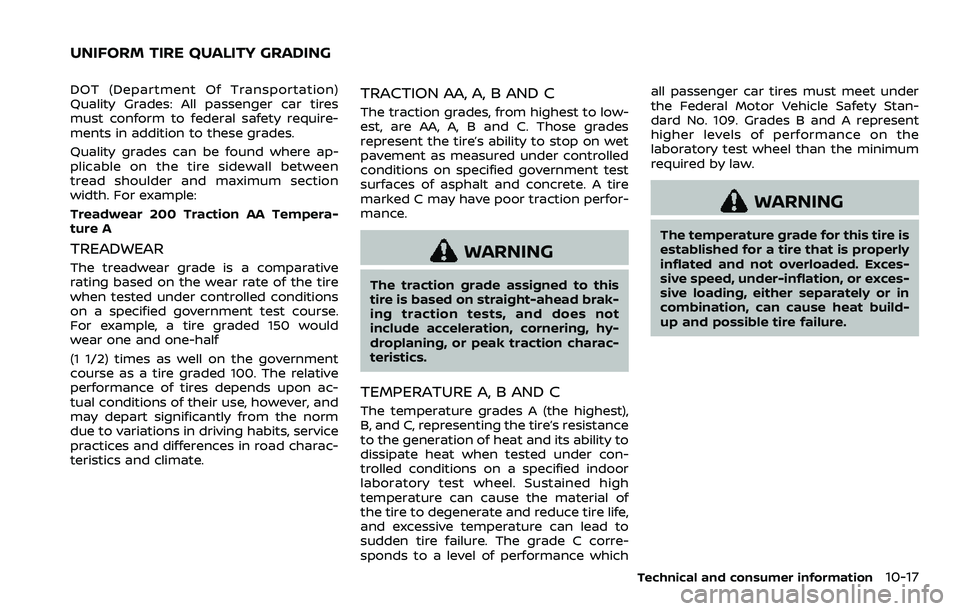
DOT (Department Of Transportation)
Quality Grades: All passenger car tires
must conform to federal safety require-
ments in addition to these grades.
Quality grades can be found where ap-
plicable on the tire sidewall between
tread shoulder and maximum section
width. For example:
Treadwear 200 Traction AA Tempera-
ture A
TREADWEAR
The treadwear grade is a comparative
rating based on the wear rate of the tire
when tested under controlled conditions
on a specified government test course.
For example, a tire graded 150 would
wear one and one-half
(1 1/2) times as well on the government
course as a tire graded 100. The relative
performance of tires depends upon ac-
tual conditions of their use, however, and
may depart significantly from the norm
due to variations in driving habits, service
practices and differences in road charac-
teristics and climate.
TRACTION AA, A, B AND C
The traction grades, from highest to low-
est, are AA, A, B and C. Those grades
represent the tire’s ability to stop on wet
pavement as measured under controlled
conditions on specified government test
surfaces of asphalt and concrete. A tire
marked C may have poor traction perfor-
mance.
WARNING
The traction grade assigned to this
tire is based on straight-ahead brak-
ing traction tests, and does not
include acceleration, cornering, hy-
droplaning, or peak traction charac-
teristics.
TEMPERATURE A, B AND C
The temperature grades A (the highest),
B, and C, representing the tire’s resistance
to the generation of heat and its ability to
dissipate heat when tested under con-
trolled conditions on a specified indoor
laboratory test wheel. Sustained high
temperature can cause the material of
the tire to degenerate and reduce tire life,
and excessive temperature can lead to
sudden tire failure. The grade C corre-
sponds to a level of performance whichall passenger car tires must meet under
the Federal Motor Vehicle Safety Stan-
dard No. 109. Grades B and A represent
higher levels of performance on the
laboratory test wheel than the minimum
required by law.
WARNING
The temperature grade for this tire is
established for a tire that is properly
inflated and not overloaded. Exces-
sive speed, under-inflation, or exces-
sive loading, either separately or in
combination, can cause heat build-
up and possible tire failure.
Technical and consumer information10-17
UNIFORM TIRE QUALITY GRADING
Page 494 of 508
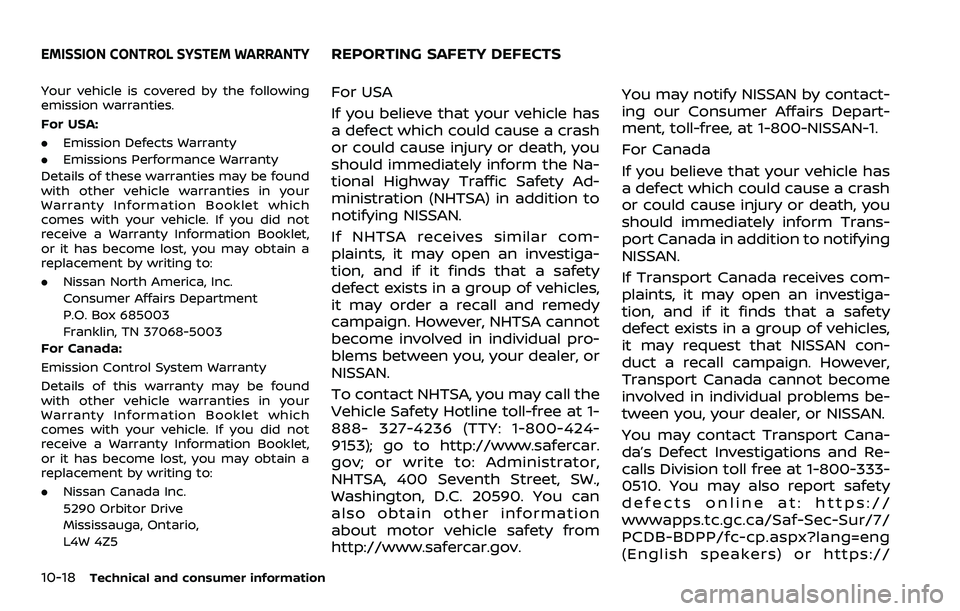
10-18Technical and consumer information
Your vehicle is covered by the following
emission warranties.
For USA:
.Emission Defects Warranty
. Emissions Performance Warranty
Details of these warranties may be found
with other vehicle warranties in your
Warranty Information Booklet which
comes with your vehicle. If you did not
receive a Warranty Information Booklet,
or it has become lost, you may obtain a
replacement by writing to:
. Nissan North America, Inc.
Consumer Affairs Department
P.O. Box 685003
Franklin, TN 37068-5003
For Canada:
Emission Control System Warranty
Details of this warranty may be found
with other vehicle warranties in your
Warranty Information Booklet which
comes with your vehicle. If you did not
receive a Warranty Information Booklet,
or it has become lost, you may obtain a
replacement by writing to:
. Nissan Canada Inc.
5290 Orbitor Drive
Mississauga, Ontario,
L4W 4Z5For USA
If you believe that your vehicle has
a defect which could cause a crash
or could cause injury or death, you
should immediately inform the Na-
tional Highway Traffic Safety Ad-
ministration (NHTSA) in addition to
notifying NISSAN.
If NHTSA receives similar com-
plaints, it may open an investiga-
tion, and if it finds that a safety
defect exists in a group of vehicles,
it may order a recall and remedy
campaign. However, NHTSA cannot
become involved in individual pro-
blems between you, your dealer, or
NISSAN.
To contact NHTSA, you may call the
Vehicle Safety Hotline toll-free at 1-
888- 327-4236 (TTY: 1-800-424-
9153); go to http://www.safercar.
gov; or write to: Administrator,
NHTSA, 400 Seventh Street, SW.,
Washington, D.C. 20590. You can
also obtain other information
about motor vehicle safety from
http://www.safercar.gov. You may notify NISSAN by contact-
ing our Consumer Affairs Depart-
ment, toll-free, at 1-800-NISSAN-1.
For Canada
If you believe that your vehicle has
a defect which could cause a crash
or could cause injury or death, you
should immediately inform Trans-
port Canada in addition to notifying
NISSAN.
If Transport Canada receives com-
plaints, it may open an investiga-
tion, and if it finds that a safety
defect exists in a group of vehicles,
it may request that NISSAN con-
duct a recall campaign. However,
Transport Canada cannot become
involved in individual problems be-
tween you, your dealer, or NISSAN.
You may contact Transport Cana-
da’s Defect Investigations and Re-
calls Division toll free at 1-800-333-
0510. You may also report safety
defects online at: https://
wwwapps.tc.gc.ca/Saf-Sec-Sur/7/
PCDB-BDPP/fc-cp.aspx?lang=eng
(English speakers) or https://
EMISSION CONTROL SYSTEM WARRANTYREPORTING SAFETY DEFECTS
Page 495 of 508
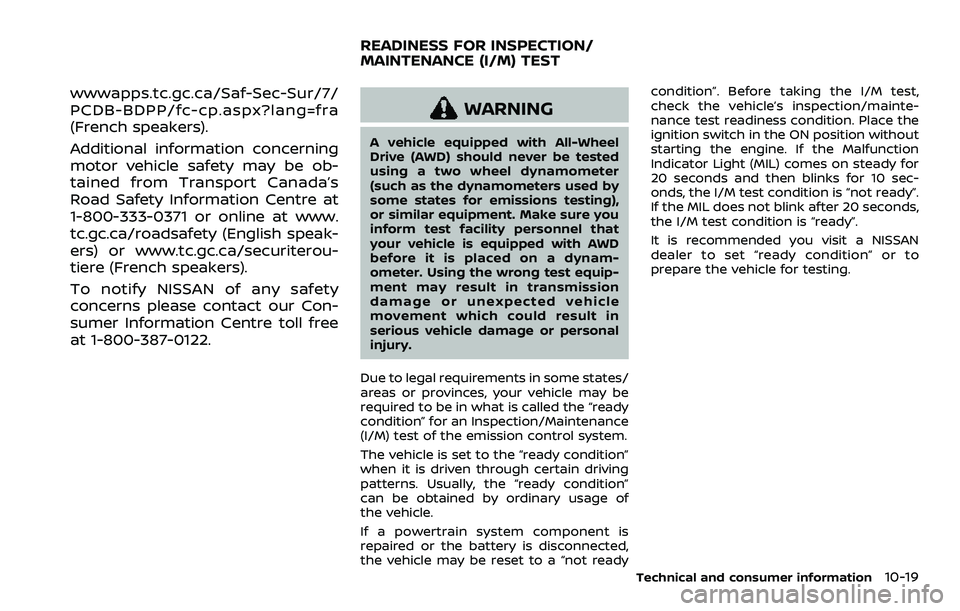
wwwapps.tc.gc.ca/Saf-Sec-Sur/7/
PCDB-BDPP/fc-cp.aspx?lang=fra
(French speakers).
Additional information concerning
motor vehicle safety may be ob-
tained from Transport Canada’s
Road Safety Information Centre at
1-800-333-0371 or online at www.
tc.gc.ca/roadsafety (English speak-
ers) or www.tc.gc.ca/securiterou-
tiere (French speakers).
To notify NISSAN of any safety
concerns please contact our Con-
sumer Information Centre toll free
at 1-800-387-0122.
WARNING
A vehicle equipped with All-Wheel
Drive (AWD) should never be tested
using a two wheel dynamometer
(such as the dynamometers used by
some states for emissions testing),
or similar equipment. Make sure you
inform test facility personnel that
your vehicle is equipped with AWD
before it is placed on a dynam-
ometer. Using the wrong test equip-
ment may result in transmission
damage or unexpected vehicle
movement which could result in
serious vehicle damage or personal
injury.
Due to legal requirements in some states/
areas or provinces, your vehicle may be
required to be in what is called the “ready
condition” for an Inspection/Maintenance
(I/M) test of the emission control system.
The vehicle is set to the “ready condition”
when it is driven through certain driving
patterns. Usually, the “ready condition”
can be obtained by ordinary usage of
the vehicle.
If a powertrain system component is
repaired or the battery is disconnected,
the vehicle may be reset to a “not ready condition”. Before taking the I/M test,
check the vehicle’s inspection/mainte-
nance test readiness condition. Place the
ignition switch in the ON position without
starting the engine. If the Malfunction
Indicator Light (MIL) comes on steady for
20 seconds and then blinks for 10 sec-
onds, the I/M test condition is “not ready”.
If the MIL does not blink after 20 seconds,
the I/M test condition is “ready”.
It is recommended you visit a NISSAN
dealer to set “ready condition” or to
prepare the vehicle for testing.
Technical and consumer information10-19
READINESS FOR INSPECTION/
MAINTENANCE (I/M) TEST
Page 496 of 508
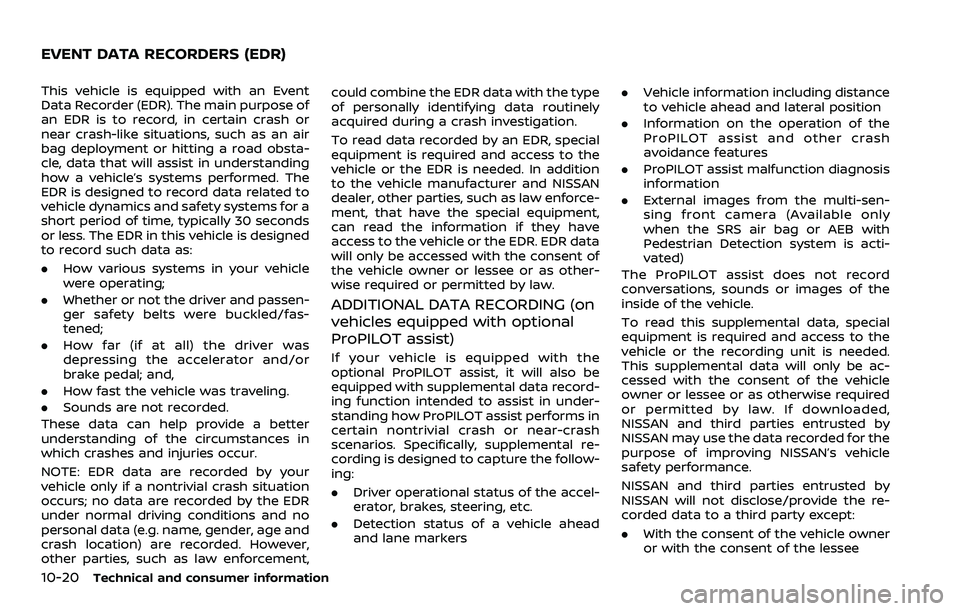
10-20Technical and consumer information
This vehicle is equipped with an Event
Data Recorder (EDR). The main purpose of
an EDR is to record, in certain crash or
near crash-like situations, such as an air
bag deployment or hitting a road obsta-
cle, data that will assist in understanding
how a vehicle’s systems performed. The
EDR is designed to record data related to
vehicle dynamics and safety systems for a
short period of time, typically 30 seconds
or less. The EDR in this vehicle is designed
to record such data as:
.How various systems in your vehicle
were operating;
. Whether or not the driver and passen-
ger safety belts were buckled/fas-
tened;
. How far (if at all) the driver was
depressing the accelerator and/or
brake pedal; and,
. How fast the vehicle was traveling.
. Sounds are not recorded.
These data can help provide a better
understanding of the circumstances in
which crashes and injuries occur.
NOTE: EDR data are recorded by your
vehicle only if a nontrivial crash situation
occurs; no data are recorded by the EDR
under normal driving conditions and no
personal data (e.g. name, gender, age and
crash location) are recorded. However,
other parties, such as law enforcement, could combine the EDR data with the type
of personally identifying data routinely
acquired during a crash investigation.
To read data recorded by an EDR, special
equipment is required and access to the
vehicle or the EDR is needed. In addition
to the vehicle manufacturer and NISSAN
dealer, other parties, such as law enforce-
ment, that have the special equipment,
can read the information if they have
access to the vehicle or the EDR. EDR data
will only be accessed with the consent of
the vehicle owner or lessee or as other-
wise required or permitted by law.
ADDITIONAL DATA RECORDING (on
vehicles equipped with optional
ProPILOT assist)
If your vehicle is equipped with the
optional ProPILOT assist, it will also be
equipped with supplemental data record-
ing function intended to assist in under-
standing how ProPILOT assist performs in
certain nontrivial crash or near-crash
scenarios. Specifically, supplemental re-
cording is designed to capture the follow-
ing:
.
Driver operational status of the accel-
erator, brakes, steering, etc.
. Detection status of a vehicle ahead
and lane markers .
Vehicle information including distance
to vehicle ahead and lateral position
. Information on the operation of the
ProPILOT assist and other crash
avoidance features
. ProPILOT assist malfunction diagnosis
information
. External images from the multi-sen-
sing front camera (Available only
when the SRS air bag or AEB with
Pedestrian Detection system is acti-
vated)
The ProPILOT assist does not record
conversations, sounds or images of the
inside of the vehicle.
To read this supplemental data, special
equipment is required and access to the
vehicle or the recording unit is needed.
This supplemental data will only be ac-
cessed with the consent of the vehicle
owner or lessee or as otherwise required
or permitted by law. If downloaded,
NISSAN and third parties entrusted by
NISSAN may use the data recorded for the
purpose of improving NISSAN’s vehicle
safety performance.
NISSAN and third parties entrusted by
NISSAN will not disclose/provide the re-
corded data to a third party except:
. With the consent of the vehicle owner
or with the consent of the lessee
EVENT DATA RECORDERS (EDR)
Page 497 of 508
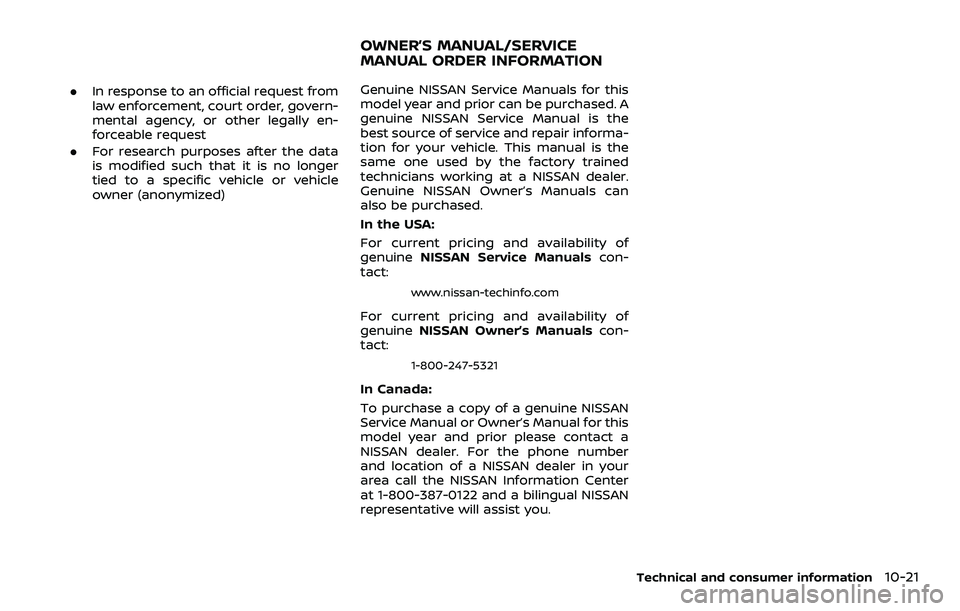
.In response to an official request from
law enforcement, court order, govern-
mental agency, or other legally en-
forceable request
. For research purposes after the data
is modified such that it is no longer
tied to a specific vehicle or vehicle
owner (anonymized) Genuine NISSAN Service Manuals for this
model year and prior can be purchased. A
genuine NISSAN Service Manual is the
best source of service and repair informa-
tion for your vehicle. This manual is the
same one used by the factory trained
technicians working at a NISSAN dealer.
Genuine NISSAN Owner’s Manuals can
also be purchased.
In the USA:
For current pricing and availability of
genuine
NISSAN Service Manuals con-
tact:
www.nissan-techinfo.com
For current pricing and availability of
genuine NISSAN Owner’s Manuals con-
tact:
1-800-247-5321
In Canada:
To purchase a copy of a genuine NISSAN
Service Manual or Owner’s Manual for this
model year and prior please contact a
NISSAN dealer. For the phone number
and location of a NISSAN dealer in your
area call the NISSAN Information Center
at 1-800-387-0122 and a bilingual NISSAN
representative will assist you.
Technical and consumer information10-21
OWNER’S MANUAL/SERVICE
MANUAL ORDER INFORMATION
Page 498 of 508
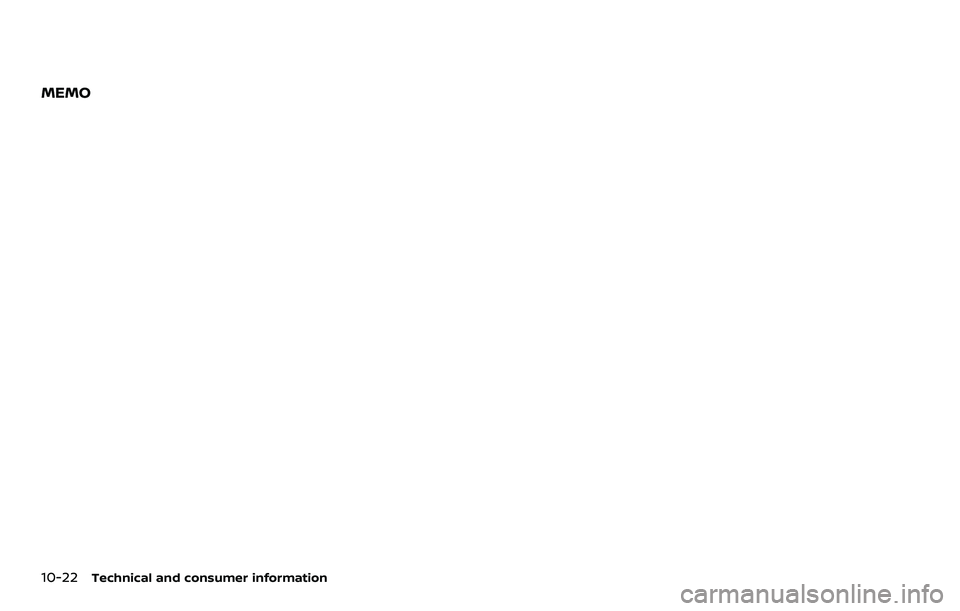
10-22Technical and consumer information
MEMO
Page 499 of 508
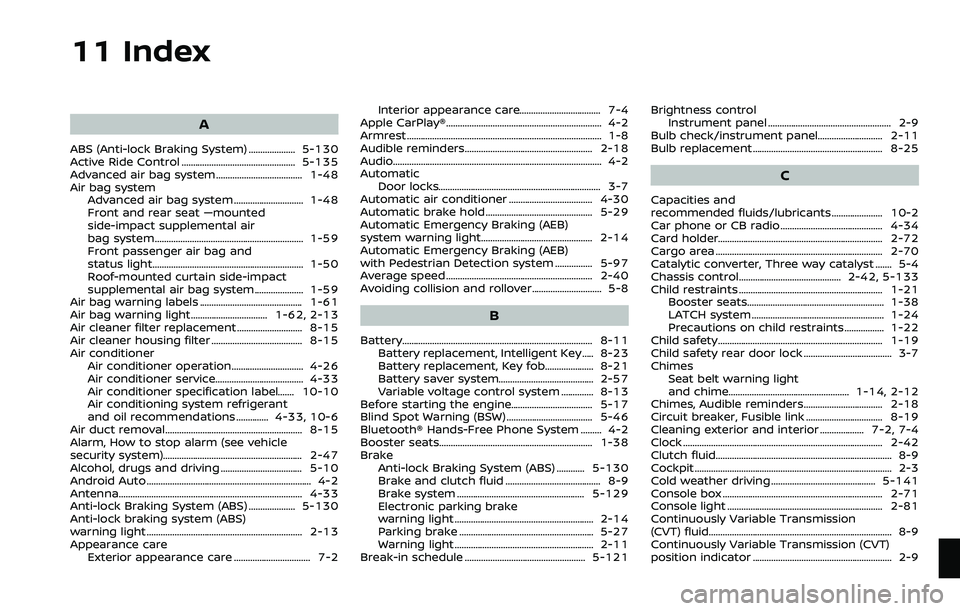
11 Index
A
ABS (Anti-lock Braking System) .................... 5-130
Active Ride Control ................................................. 5-135
Advanced air bag system ..................................... 1-48
Air bag systemAdvanced air bag system .............................. 1-48
Front and rear seat —mounted
side-impact supplemental air
bag system................................................................ 1-59
Front passenger air bag and
status light................................................................. 1-50
Roof-mounted curtain side-impact
supplemental air bag system..................... 1-59
Air bag warning labels ............................................ 1-61
Air bag warning light................................. 1-62, 2-13
Air cleaner filter replacement ............................ 8-15
Air cleaner housing filter ....................................... 8-15
Air conditioner Air conditioner operation............................... 4-26
Air conditioner service...................................... 4-33
Air conditioner specification label....... 10-10
Air conditioning system refrigerant
and oil recommendations .............. 4-33, 10-6
Air duct removal........................................................... 8-15
Alarm, How to stop alarm (see vehicle
security system)............................................................ 2-47
Alcohol, drugs and driving ................................... 5-10
Android Auto ....................................................................... 4-2
Antenna........................................................................\
....... 4-33
Anti-lock Braking System (ABS) .................... 5-130
Anti-lock braking system (ABS)
warning light ................................................................... 2-13
Appearance care Exterior appearance care ................................. 7-2 Interior appearance care................................... 7-4
Apple CarPlay®................................................................... 4-2
Armrest ........................................................................\
............ 1-8
Audible reminders....................................................... 2-18
Audio........................................................................\
.................. 4-2
Automatic Door locks...................................................................... 3-7
Automatic air conditioner .................................... 4-30
Automatic brake hold .............................................. 5-29
Automatic Emergency Braking (AEB)
system warning light................................................ 2-14
Automatic Emergency Braking (AEB)
with Pedestrian Detection system ................ 5-97
Average speed ............................................................... 2-40
Avoiding collision and rollover.............................. 5-8
B
Battery........................................................................\
.......... 8-11 Battery replacement, Intelligent Key ..... 8-23
Battery replacement, Key fob..................... 8-21
Battery saver system......................................... 2-57
Variable voltage control system .............. 8-13
Before starting the engine................................... 5-17
Blind Spot Warning (BSW) ..................................... 5-46
Bluetooth® Hands-Free Phone System ......... 4-2
Booster seats.................................................................. 1-38
Brake Anti-lock Braking System (ABS) ............ 5-130
Brake and clutch fluid ......................................... 8-9
Brake system ....................................................... 5-129
Electronic parking brake
warning light ............................................................ 2-14
Parking brake .......................................................... 5-27
Warning light............................................................ 2-11
Break-in schedule .................................................... 5-121 Brightness control
Instrument panel ..................................................... 2-9
Bulb check/instrument panel............................ 2-11
Bulb replacement ........................................................ 8-25
C
Capacities and
recommended fluids/lubricants...................... 10-2
Car phone or CB radio ............................................ 4-34
Card holder....................................................................... 2-72
Cargo area ........................................................................\
2-70
Catalytic converter, Three way catalyst ....... 5-4
Chassis control............................................ 2-42, 5-133
Child restraints .............................................................. 1-21 Booster seats........................................................... 1-38
LATCH system ......................................................... 1-24
Precautions on child restraints................. 1-22
Child safety....................................................................... 1-19
Child safety rear door lock ...................................... 3-7
Chimes Seat belt warning light
and chime.................................................... 1-14, 2-12
Chimes, Audible reminders.................................. 2-18
Circuit breaker, Fusible link ................................. 8-19
Cleaning exterior and interior ................... 7-2, 7-4
Clock ........................................................................\
.............. 2-42
Clutch fluid........................................................................\
.... 8-9
Cockpit ........................................................................\
............. 2-3
Cold weather driving ............................................. 5-141
Console box ..................................................................... 2-71
Console light ................................................................... 2-81
Continuously Variable Transmission
(CVT) fluid........................................................................\
....... 8-9
Continuously Variable Transmission (CVT)
position indicator ............................................................ 2-9
Page 500 of 508
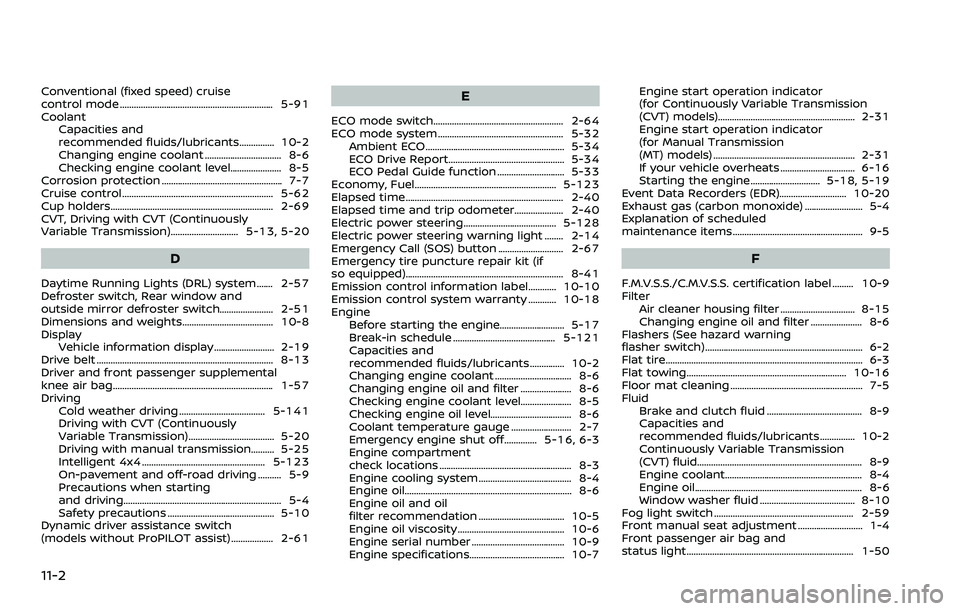
11-2
Conventional (fixed speed) cruise
control mode .................................................................. 5-91
CoolantCapacities and
recommended fluids/lubricants............... 10-2
Changing engine coolant ................................. 8-6
Checking engine coolant level...................... 8-5
Corrosion protection .................................................... 7-7
Cruise control ................................................................. 5-62
Cup holders...................................................................... 2-69
CVT, Driving with CVT (Continuously
Variable Transmission)............................. 5-13, 5-20
D
Daytime Running Lights (DRL) system....... 2-57
Defroster switch, Rear window and
outside mirror defroster switch....................... 2-51
Dimensions and weights....................................... 10-8
Display Vehicle information display.......................... 2-19
Drive belt ........................................................................\
.... 8-13
Driver and front passenger supplemental
knee air bag..................................................................... 1-57
Driving Cold weather driving ..................................... 5-141
Driving with CVT (Continuously
Variable Transmission)..................................... 5-20
Driving with manual transmission.......... 5-25
Intelligent 4x4 ..................................................... 5-123
On-pavement and off-road driving .......... 5-9
Precautions when starting
and driving.................................................................... 5-4
Safety precautions .............................................. 5-10
Dynamic driver assistance switch
(models without ProPILOT assist) .................. 2-61
E
ECO mode switch........................................................ 2-64
ECO mode system ...................................................... 5-32 Ambient ECO............................................................ 5-34
ECO Drive Report.................................................. 5-34
ECO Pedal Guide function ............................. 5-33
Economy, Fuel............................................................. 5-123
Elapsed time.................................................................... 2-40
Elapsed time and trip odometer..................... 2-40
Electric power steering........................................ 5-128
Electric power steering warning light ........ 2-14
Emergency Call (SOS) button ............................ 2-67
Emergency tire puncture repair kit (if
so equipped).................................................................... 8-41
Emission control information label............ 10-10
Emission control system warranty ............ 10-18
Engine Before starting the engine............................ 5-17
Break-in schedule ............................................ 5-121
Capacities and
recommended fluids/lubricants............... 10-2
Changing engine coolant ................................. 8-6
Changing engine oil and filter ...................... 8-6
Checking engine coolant level...................... 8-5
Checking engine oil level................................... 8-6
Coolant temperature gauge .......................... 2-7
Emergency engine shut off.............. 5-16, 6-3
Engine compartment
check locations ......................................................... 8-3
Engine cooling system ........................................ 8-4
Engine oil.....................................................................\
... 8-6
Engine oil and oil
filter recommendation ..................................... 10-5
Engine oil viscosity .............................................. 10-6
Engine serial number ........................................ 10-9
Engine specifications......................................... 10-7 Engine start operation indicator
(for Continuously Variable Transmission
(CVT) models)........................................................... 2-31
Engine start operation indicator
(for Manual Transmission
(MT) models) ............................................................. 2-31
If your vehicle overheats ................................ 6-16
Starting the engine.............................. 5-18, 5-19
Event Data Recorders (EDR)............................. 10-20
Exhaust gas (carbon monoxide) ......................... 5-4
Explanation of scheduled
maintenance items ........................................................ 9-5
F
F.M.V.S.S./C.M.V.S.S. certification label ......... 10-9
Filter Air cleaner housing filter ................................ 8-15
Changing engine oil and filter ...................... 8-6
Flashers (See hazard warning
flasher switch).................................................................... 6-2
Flat tire........................................................................\
............. 6-3
Flat towing..................................................................... 10-16
Floor mat cleaning ......................................................... 7-5
Fluid Brake and clutch fluid ......................................... 8-9
Capacities and
recommended fluids/lubricants............... 10-2
Continuously Variable Transmission
(CVT) fluid....................................................................... 8-9
Engine coolant........................................................... 8-4
Engine oil.....................................................................\
... 8-6
Window washer fluid ......................................... 8-10
Fog light switch ............................................................ 2-59
Front manual seat adjustment ............................ 1-4
Front passenger air bag and
status light........................................................................\
1-50